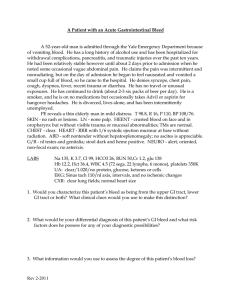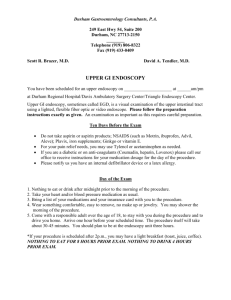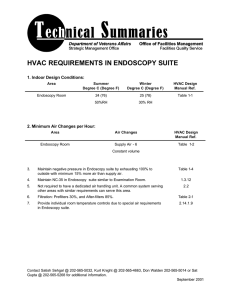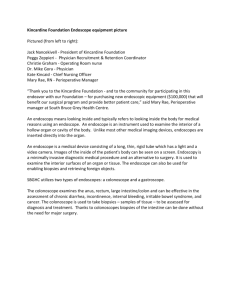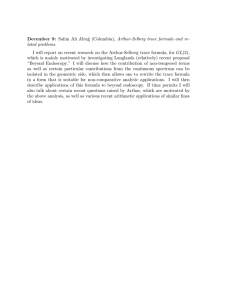Medical Instrumentation
advertisement
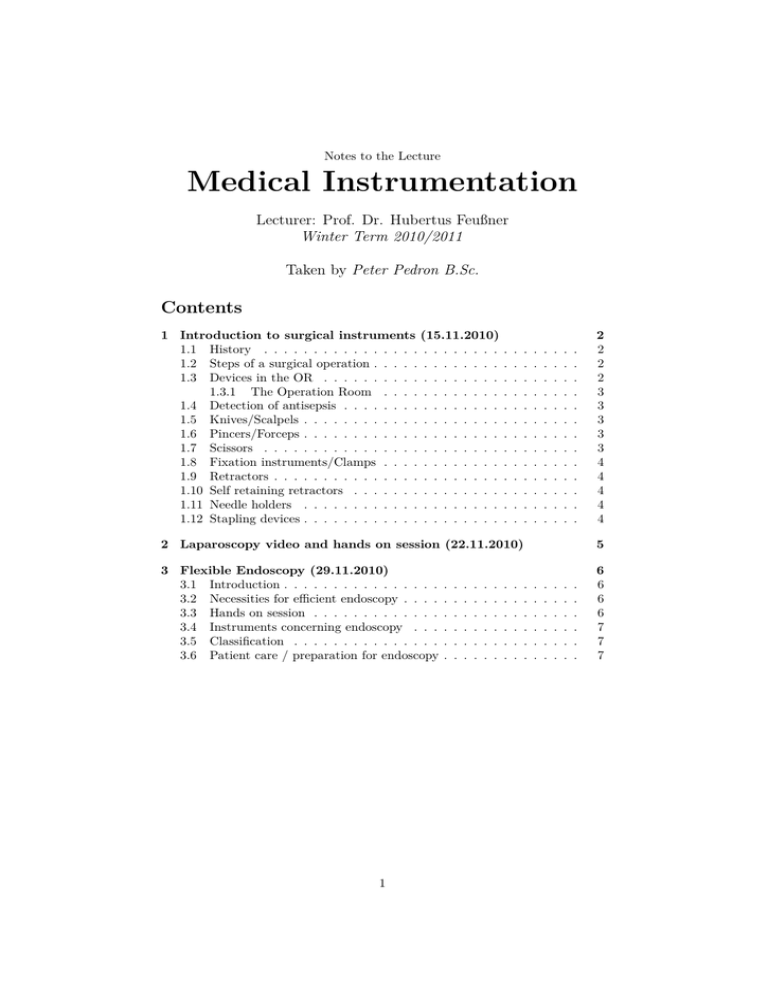
Notes to the Lecture Medical Instrumentation Lecturer: Prof. Dr. Hubertus Feußner Winter Term 2010/2011 Taken by Peter Pedron B.Sc. Contents 1 Introduction to surgical instruments (15.11.2010) 1.1 History . . . . . . . . . . . . . . . . . . . . . . . . 1.2 Steps of a surgical operation . . . . . . . . . . . . . 1.3 Devices in the OR . . . . . . . . . . . . . . . . . . 1.3.1 The Operation Room . . . . . . . . . . . . 1.4 Detection of antisepsis . . . . . . . . . . . . . . . . 1.5 Knives/Scalpels . . . . . . . . . . . . . . . . . . . . 1.6 Pincers/Forceps . . . . . . . . . . . . . . . . . . . . 1.7 Scissors . . . . . . . . . . . . . . . . . . . . . . . . 1.8 Fixation instruments/Clamps . . . . . . . . . . . . 1.9 Retractors . . . . . . . . . . . . . . . . . . . . . . . 1.10 Self retaining retractors . . . . . . . . . . . . . . . 1.11 Needle holders . . . . . . . . . . . . . . . . . . . . 1.12 Stapling devices . . . . . . . . . . . . . . . . . . . . . . . . . . . . . . . . . . . . . . . . . . . . . . . . . . . . . . . . . . . . . . . . . . . . . . . . . . . . . . . . . . . . . . . . . . . . . . . . . . . . . . . . . . . . . . . . . . . . . . . . . . . . 2 Laparoscopy video and hands on session (22.11.2010) 3 Flexible Endoscopy (29.11.2010) 3.1 Introduction . . . . . . . . . . . . . . . . 3.2 Necessities for efficient endoscopy . . . . 3.3 Hands on session . . . . . . . . . . . . . 3.4 Instruments concerning endoscopy . . . 3.5 Classification . . . . . . . . . . . . . . . 3.6 Patient care / preparation for endoscopy 1 . . . . . . . . . . . . . . . . . . . . . . . . . . . . . . . . . . . . . . . . . . . . . . . . . . . . . . 2 2 2 2 3 3 3 3 3 4 4 4 4 4 5 . . . . . . . . . . . . . . . . . . . . . . . . . . . . . . 6 6 6 6 7 7 7 1 Introduction to surgical instruments (15.11.2010) 1.1 History Scientific is not pretty old. In fact, it was integrated not before about 1860 AD (150 years ago) into the modern sciences. In the time before, medicine was a skill. Surgical operations were performed mainly by barbers (e.g. pulling out teeth). 1.2 Steps of a surgical operation 1. positioning of the patient 2. Invasion 3. Exposition of the surgical site 4. Dissection/Preparation 5. Resection (removal, cut out) 6. Specimen retrieval 7. Viscerosynthesis (reconstruct the anatomy). 8. Wound closure 1.3 Devices in the OR Medical devices are needed for • Anaestesia • Disinfection/Sterilisation • Positioning of the patient Anaesthesia has three purposes. It allows the patient to be free of pain, to lose conscienceness and hence to sleep and finally it helps to eliminate the muscletonus. Thus the patient might be totally relaxed which is helpful for the surgeon because he wishes the body as soft as possible. As a consequence to the complete relaxation of the muscles also the muscles used for respiration won’t contract anymore. Therefore artificial respiration is needed which will compensate this issue. The order of application of the different anaestesic agents which are given to the patient commences with the agent for sleep. Then the actual anaestesic agent and the relaxation agent are applied. If this order is not considered, the patient undergoes a real torture. Opium, ether, chloroform and alcohol were the first tries for anaestesic agents. A former utility for inhalation of these agents is the Schimmelbusch mask. Modern anaesthesia uses a tube directly into the trachea which originates from a device that pumps a gas mixture in regular doses into the lungs. 2 1.3.1 The Operation Room The operation room was introduced at about 1900 AD. It was thought as a dedicated place for surgery. In th first variants there was only a table. Today the modern OR is equipped with many medical high-technology devices. Also the patient table is a high-technology device that allows the patient to take every position needed for the operation. 1.4 Detection of antisepsis • Reduction of germs • Disinfection • Sterilisation The Hungarian Prof. Semmelweis was the first to detect germs in a hospital in Vienna at about 1865 AD. He began to use gloves and sterile container because he observed a significant improvement of the healing after surgical operations using sterile hands and equipment. 1.5 Knives/Scalpels • standard disposable scalpels • miscellaneous blades for different purposes • Historical re-usable scalpels • amputation knife Scalpels are uses only for incisions into the skin. 1.6 Pincers/Forceps • Anatomical • Surgical (has hooks at the end, that makes fixation easier) 1.7 Scissors • Normal dissection scissors • Vascular scissors • Rib scissors • Dressing scissors Surgery scissors are slightly bent. 3 1.8 Fixation instruments/Clamps • Duval • Backhaus • Mikulicz • Babcock • Collin • Allis Vascular clamps: • Bulldog • Satinsky • Cooley • Dardlik The function of these instruments is to keep the tissue in a well-defined position. 1.9 Retractors • Gillies • Volkmann • Langenbeck • Roux • Fritsche • Doyen 1.10 Self retaining retractors • Weilander/Zenker 1.11 Needle holders • Hegar • Matthieu 1.12 Stapling devices Stapling devices are used instead of suturing. It uses clips to fixate to parts of tissue. These devices are very precise and are often used. There are two types • Linear stapling devices • Circular stapling devices (CEEA - Circular end to end stapler) The procedure to connect to tubes is called Anastomosis. 4 2 Laparoscopy video and hands on session (22.11.2010) We watched some videos of laparoscopic operations. After that we could get a first experience how it feels using the laparoscopes and cameras seen a minute before. 5 3 Flexible Endoscopy (29.11.2010) 3.1 Introduction Endoscopes are used to look into the gastroinstestinal tract. To achieve this, we need flexible instruments. In the last century it was only possible to examinate the patient from outside. The first steps to look into the body were tubes that were introduced into the abdomen (like laparoscopy). Then X-ray made it possible to hava a closer look to the inside. Then sonography and finally computed tomography came to help the phisicists. The first idea on endoscopy had an Italian physicist in Frankfurt. He was first of thinking on illumination and made his trials in the last part of the colon. Short history 1807 Bozzini (the guy from Frankfurt) 1822 Beaumont - first endolumenal endoscopic examination 1908 David - integration of a bulb into endoscopes 1901 von Valling 1950 Fibre optics - Hopkins endoscope 1952 first gastroscope (Olympus) 1980 chip on the tip endoscope 2005 multichannel endoscope 2007 multiarm endoscopic intervention devices Future capsules that wander through the gastrointestinal tract 3.2 Necessities for efficient endoscopy • light • optical system • flexible conductor / transmitter • working channels / control / insufflation / instruments 3.3 Hands on session We could use a flexible endoscope to inspect the big bowel of a human dummy. We also could try a working channel biopsy/cutting tool. One was destructed. 6 3.4 Instruments concerning endoscopy • gastroscope • coloscope (longer/larger than the gastroscope) • to investigate the small bowel neither the gastroscope nor the coloscope might be used. There exists a certain variant, called push and pull endoscopy, that uses two small balloons which are inflated in turn to move the endoscope forward. This is a time-consuming work, but at least one is able to investigate this region of the body. Some instruments/tools used in the device mentioned above: • insufflation • video screen • suction • light source • video device • capturing device (recorder) • coagulation device (homeostasis) • irrigation • forceps • snares (with current) to stop bleeding after removal of e.g. a polype • canulas (= injection needles) to inject agents 3.5 Classification • flexible vs. stiff endoscopy (laparoscopy) • diagnostic vs. interventional endoscopy 3.6 Patient care / preparation for endoscopy • bowel preparation (cleansing) - coloscopy • fasting - gastroscopy • sedation with propofol / midazolame • monitoring of blood pressure and oxygen saturation • leftsided position • postendsoscopic observation • ambulant examination The ability of the endoscope to navigate into the backward direction is called retroflection. An interesting project on endoscopy is ARAKNES. 7
